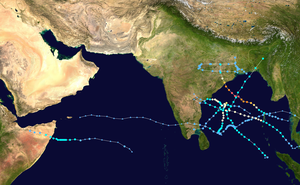| 2013 North Indian Ocean cyclone season | |
|---|---|
 Season summary map | |
| Seasonal boundaries | |
| First system formed | May 10, 2013 |
| Last system dissipated | December 13, 2013 |
| Strongest storm | |
| Name | Phailin |
| • Maximum winds | 215 km/h (130 mph) (3-minute sustained) |
| • Lowest pressure | 940 hPa (mbar) |
| Seasonal statistics | |
| Depressions | 10 |
| Deep depressions | 6 |
| Cyclonic storms | 5 |
| Severe cyclonic storms | 4 |
| Very severe cyclonic storms | 3 |
| Extremely severe cyclonic storms | 1 |
| Total fatalities | 323 total |
| Total damage | > $5.09 billion (2013 USD) |
| Related articles | |
The 2013 North Indian Ocean cyclone season was an event in the annual cycle of tropical cyclone formation, in which tropical cyclones formed in the North Indian Ocean and Arabian Sea. The season had no official bounds, but cyclones typically formed between May and December, with the peak from October to November. These dates conventionally delimit the period of each year when most tropical cyclones form in the northern Indian Ocean.
The scope of this article is limited to the Indian Ocean in the Northern Hemisphere, east of the Horn of Africa and west of the Malay Peninsula. There are two main seas in the North Indian Ocean — the Arabian Sea to the west of the Indian subcontinent, abbreviated ARB by the India Meteorological Department (IMD); and the Bay of Bengal to the east, abbreviated BOB by the IMD.
The official Regional Specialized Meteorological Centre in this basin is the India Meteorological Department (IMD), while the Joint Typhoon Warning Center releases unofficial advisories. On average, 4 to 6 storms form in this basin every season.[1]
- ^ "IMD Cyclone Warning Services: Tropical Cyclones". Archived from the original on May 29, 2009.